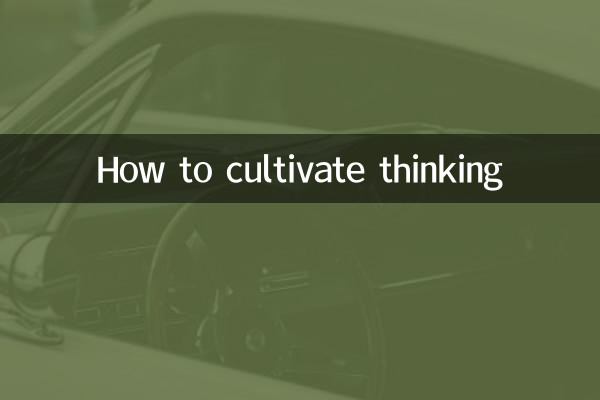How to cultivate thinking: looking at the development of deep thinking from the perspective of hot topics
In the era of information explosion, cultivating independent thinking ability has become the core competitiveness of personal growth. By analyzing the hot topics across the Internet in the past 10 days, we found that there are often excellent materials for thinking training hidden behind hot events. The following is a structured analysis combining hot content and specific methods on how to use this content to cultivate thinking.
1. Overview of recent hot topic data

| Ranking | hot topics | heat index | key discussion points |
|---|---|---|---|
| 1 | A celebrity’s divorce | 980 million | Boundaries of privacy rights of public figures |
| 2 | New education policy | 720 million | Balance between quality education and examination-oriented education |
| 3 | International Science and Technology Conference | 650 million | Artificial Intelligence Ethical Issues |
| 4 | Extreme weather somewhere | 590 million | climate change response |
| 5 | Internet celebrity catering hygiene issues | 430 million | Market supervision and consumer rights |
2. The cultivation path from hot spots to thinking
1.Observation and questioning: the first step to start thinking
Take the "celebrity divorce incident" as an example. Don't stay at the level of gossip, but think about:
- Why is the public so concerned about celebrity privacy?
- Where are the boundaries of media coverage?
- What is the social impact mechanism of this type of incident?
2.Multi-angle analysis: establishing a three-dimensional thinking framework
Regarding "education policy reform", we can think from the following dimensions:
| angle | Thinking about the problem | value point |
|---|---|---|
| Parent's perspective | How to adjust family education strategies | Develop adaptability |
| Teacher's perspective | What changes are needed in teaching methods? | professional development |
| policy makers | Forecasting Difficulties in Policy Implementation | systems thinking |
| Student perspective | How learning will change | self-awareness |
3.Deep thinking training: from phenomenon to essence
Taking the hot topic of "artificial intelligence ethics" as an example, it is recommended to use the "5W1H" thinking method:
-What: What does artificial intelligence ethics specifically refer to?
-Why: Why is it becoming a focus issue now?
-Who: Who should be responsible for AI behavior
-When: At what stage should ethical norms be involved?
-Where: Which areas require the most attention to ethics?
-How: How to establish an effective regulatory mechanism
3. Structured thinking training tools
| Tool name | Applicable scenarios | training effect |
|---|---|---|
| mind map | Breaking down complex problems | Improve logic |
| SWOT analysis | decision making judgment | Enhance comprehensiveness |
| six thinking hats | Thinking from multiple perspectives | Cultivate empathy |
| pyramid principle | Expression of opinions | Improve persuasiveness |
4. Practical Suggestions: Transform hot spots into thinking training ground
1.Create hotspot tracking file: Choose 3 hot events every week, record your initial opinions, review and revise them after a week.
2.Organizing Thinking Groups: Regularly discuss hot topics with friends and compare the similarities and differences between different perspectives.
3.Write analysis report: Conduct an in-depth analysis of more than 500 words on hot topics of interest.
4.Simulated decision training: Assuming that you are the relevant decision-maker, how would you handle this hot event.
The mind is like a muscle and needs constant exercise to stay active. By systematically using hot events as thinking training materials, we can not only understand the world more deeply, but also develop valuable abilities such as independent thinking, multi-angle analysis, and systematic thinking. Remember, it’s not how many hot spots you know, but what you can learn from each hot spot.

check the details

check the details